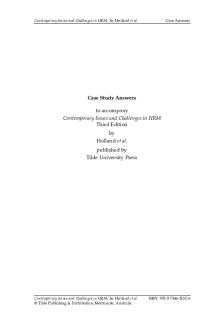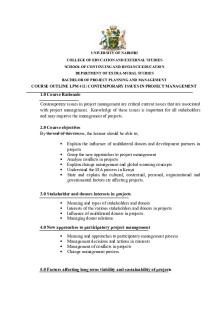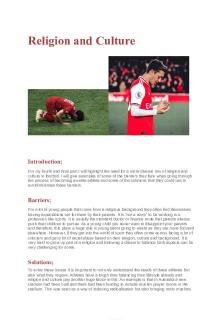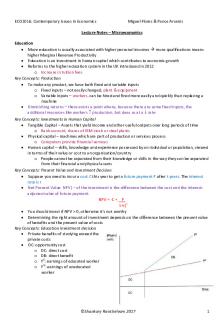Essay - Contemporary Issues in Sport & Athlete Welfare PDF

| Title | Essay - Contemporary Issues in Sport & Athlete Welfare |
|---|---|
| Course | Contemporary Issues in Sport and Athlete Welfare |
| Institution | Edge Hill University |
| Pages | 14 |
| File Size | 213.9 KB |
| File Type | |
| Total Downloads | 111 |
| Total Views | 145 |
Summary
Contemporary Issues in Sport & Athlete Welfare...
Description
Department of Sport and Physical Activity
BSc (Hons) Coach Education SPT2730 Contemporary Issues in Sport & Athlete Welfare With reference to key ideas from the sociology of childhood and using academic research from sport, critically discuss the culture of risk in contemporary youth sport and how this can compromise children’s welfare in sport.
1
Introduction With regards to the sociology of childhood, sport plays an important role in both the physical and mental wellbeing of the individual child. With this in mind, it is important to acknowledge that while there are many benefits for children within sports, one must also establish the culture of risk that exists, particularly regarding contemporary youth sport, and how this can compromise the welfare of children in sport. And so, this assignment shall firstly outline the key ideas within the sociology of childhood and how these ideas can be related to sport. Then, there will be a critical discussion regarding these findings and how issues such as child abuse in sport and how that can affect a child/athlete during and after life in sport, Intensive training in sport and the effects it has, how controlled parenting can be an issue for a child in sport and how injury in sport can cause damage to a child. These topics will use academic literature to support this evidence. Finally, the essay will have a brief conclusion on the topics and within the evidence found in the academic writing.
Sociology of Childhood The sociology of childhood mostly concerns how children’s rights are implicated and have been put into place to protect vulnerable children. A lot of sociologists see childhood as a social construction rather than a natural state. In the past, childhood didn’t exist in medieval Europe (Aries, 1962) which meant that children didn’t have the privileges that most have today. It was in the late-20th century when children were regarded as the same as adults and were expected to contribute to society in the same way that adults did. An 2
example of this treatment could be that children back then were made to work instead of getting an education. Brackenridge, 2001 states that only since 16th century has there been a gradual awareness that children are in some way different to adults. However, it was only in the early 1900s that children started to be viewed and treated differently to adults, as people started to understand that children were not able to fend for themselves, meaning they needed to be cared for and protected. Laws were enforced to protect children during the early 1900s. These laws were mainly enforced to prevent children from experiencing forced labour and neglect.
In the 1980s, children were seen as individual’s and independent members of society, which allowed them to voice their opinions and afforded them more rights. The United Nations Convention on the Rights of the Child is an organisation which was created to help implement and protect children’s rights. The UNCRC came into force in the 1990 but was only used in the UK in 1992. This organisation argues the civil, political, economic, social, health and cultural rights of children. It’s based around 4 principles: the right to life, survival and development, the right to non-discrimination, the right to protection and the right to participation (UN General Assembly, 1989). The UNCRC helps protect children in sport. Examples of such protection includes safeguarding against such dangers as violence, doping, early specialisation and over-training. This is highlighted by UNICEF (2003, p.2) stating that the protection of young athletes should be understood in the viewpoint of the principles stated in the UN Convention on the Rights of the Child. That is why
3
protection should not be understood only in terms of health and physical integrity, but also as psychological integrity.
Child Abuse in Sport This section of the essay shall focus on how child abuse has been and is still an issue within sport today. Child abuse in sport can be experienced in several ways and can have not only a physical effect on a child, but can also lead to having a mental effect throughout their lives.
Currently protection of children in sports has been improved with the government enforcing those who have any involvement with children in sport to have legal requirements to be able to work with children. These checks such as CRB checks and DBS checks are implemented as a starting block to help protect children in sport. A CRB (Criminal Records Bureau) check, more commonly known today as a DBS (Disclosure and Barring Service) check, is a background check on a person’s previous background history to make sure they are legally eligible to work with children.
Data from these check show that from 2012, the CRB system has prevented more than 130,000 unsuitable people from working with children or vulnerable groups (CRB, 2012). Whilst these checks have a positive effect on protecting children they can’t and don’t protect what someone might do in the future. Most sex offenders offend multiple times before they are caught so ‘false negatives’ are possible, for example, the recent case of abusive football coach Barry Bennell. Bennell would not have been prevented from coaching if 4
checked as he had no previous record relating to mistreatment of children before he started coaching. Former elite sporting athletes in football have finally had the courage to step forward and have been able to speak about their traumatic experience of growing up in a sports environment and being sexually abused at a young age. Recent events have led to eleven people stepping forward and speaking about the sexual abuse from ex footballing coach Barry Bennell. Retired professionals such as David White, Andy Woodward, Steve Walters and Paul Stewart have all discussed the effects of the sexual abuse they had encountered at a young age. The mental effects these traumas can lead to include illnesses such as depression and can lead to further problems in the future. Paul Stewart a former victim to Bennell stated in an interview with BBC Sport how the mental scars led him into other problems with drink and drugs. Research from Brackenridge et al., 2008 suggest how abusive coaches have been found to push back the boundaries of acceptable behavior, increasingly violating personal space, using verbal familiarity, emotional blackmail, and eventually physical contact. This can then lead to an athlete being forced to leave the sport or to be snubbed by the coach if an athlete rejects this behavior from happening. However, if an athlete allows this type of behavior to happen they may find that they become trapped into surrendering to the coach’s demands. Abusive coaches often establish a respected role among the community to conceal their unethical behavior. Intensive Training
5
This section of the essay will focus on intensive training and how it impacts children’s welfare in sport. Even though there is no definitive definition of what intensive training is, it can be described as pushing a child beyond their limits which can, in some cases, lead to harming the child physically and or mentally. An example of intensive training is a case in India which focuses on a young boy, only three years of age. Budhia came from a poor family who asked a local judo coach called Biranchi Das to take care of Budiha. As a punishment, Das used to make Budiha run. During punishments, Das noticed how good Budhia was at running so Das started training him. By the age of 4, Budhia has finished forty-eight marathons; “In Russia, Korea and China, they start training athletes at the age of three. If you don't take risks you don't get results. I am the person who took risks with Budhia, and I got results” (Das, 2006) Budhia managed to win a sports scholarship to attend boarding school in India, he now no longer runs or no longer speaks to Das. Even with success of Budhia you can argue that the intensive training he was put through can be viewed as child exploitation as he was at such a young age and was forced into running and wasn’t given the option in deciding what to do. This is supported by the findings of Raglin & Wilson who find that as children become involved in sport from younger and younger ages, they are training more and more frequently, and at an increasingly high intensity (Raglin & Wilson, 1999) which enforces the need for protective organisations and the protection of well-being for children.
6
UK Sport found that “professional adult athletes in the UK reportedly train for 21.8 hours per week” (UK Sport, 2007). However, Weimann finds that female child elite gymnasts who are around thirteen years old are found to train on average 22.1 hour per week (Weimann, 2002). These results from research show how intensive training exists more at a younger age. Intensive training can also lead to serious medical issues with the athlete. The need for the athlete to be the best they can possibly be combined with intensive training, can lead to wanting to push further and some athletes even go beyond training and use supplements to enhance their performance. However, there are few safeguarding efforts which are built into the current medical system to discourage children and adolescents from taking performance-enhancing drugs (Metzl, 2002) so young athletes are not made aware of the physical effects with using enhancements are damaging to the body. This is something that needs more attention and can potentially help to avoid maltreatment of young athletes in the future.
Control Parenting This section will discuss how parents control their children and how it can have a negative effect on their lives. In the Channel 4 documentary Trophy Kids it shows how parents control how their children live and make drastic choices on their lives. Lee Spurling was a young golfer whose parents pushed him to play the sport. In the documentary Lee’s parents discuss how they thought the best decision was to remove Lee from school and make him solely concentrate on golfing. This decision from the parents questions if what they are doing is best for the 7
child’s needs or whether it is more for their own benefit. The UNCRC implemented the rights for a child to an education so with Lee’s parents taking him out of school, the argument can be made that they are denying their child’s rights. His parents also talk about the future and how Lee is going to become successful and rich and encourage him to become more materialistic. This could put a lot of pressure onto Lee at such a young age which could take away the enjoyment of participating in sports. With Lee’s parents discussing the successes and fortune in the future, one could argue that Lee's parents see Lee and his talents as more of an investment, using his vulnerability in order to help benefit them in the future.
Another child in the documentary is a young tennis player called Eden Silva. Eden’s father helps to train and develop his daughter's tennis skills in the hope that she one day can make it as a professional. During the documentary, Eden’s father discusses why he thought the best thing for Eden was to remove her from school: this was so she could “focus on tennis” (Trophy Kids ,2009). Similarly, to Lee's case, as previously discussed, it could be argued that this decision takes away Eden’s rights to a normal childhood and a childhood education.
Eden’s father clearly invested a lot of money in his daughter so she could travel around the world in order to get the best possible coaching. In the documentary, we see Eden pick up an injury whilst training for a competition but rather than taking Eden to a physio or a doctor Eden’s father performed rehabilitation on her instead which could have caused more damage, whilst
8
telling her she had to “take the pain”. This questions whether Eden’s dad is more concerned about her success in tennis rather than Eden’s health.
Eden became professional in 2014. Although the motives from her father can be questioned, this does lead one to wonder whether pressurised environments such as the one Eden was brought up in are the best way for a young athlete to become elite and professional.
Finally, in the documentary, Charlie Edwards, a young boxer, was shown training with his father in a home made ring in the back garden of his house. Charlie’s father made him fight every night, keep in good shape for boxing and encouraged Charlie's main focus to be boxing. Unlike the other two children in the documentary, Charlie wasn’t removed from school to focus on his sport but was made to train every day without fail. This caused trouble between Charlie's mum and dad as his mum disagreed with Charlie's dad's obsession of training him so relentlessly. As consequence of this, his dad over trained him so much so that this caused his parents to split up. Charlie Edwards became professional in 2015 and has even challenged for a world championship belt. This again highlights the argument surrounding whether intense training and sacrifice is in the best interest of the child.
The documentary shows how vulnerable and powerless children in sport can be. These parents see their children as more of an investment rather than as a child with rights. The focus of the parents seem very future oriented and this can lead to too much pressure at a young age.
9
Injury in Youth Sport The final section of this essay will focus on injury in sport. Injury in youth sport links with the intensive training some children are put through as the overload and high intensity of training can cause damage to the undeveloped body. David (2005) suggests that unless a child starts training at a very early age, it is almost impossible to reach the top level. In many sports, this can lead more young children to participate in a sport more intensely and regularly than ever before (Lang, 2010).
Sport is the main cause of injury in adolescents (Abernethy & Bleakley, 2007: 627). This is because young people are at particular risk of a sporting injury due to the high levels of exposure at a time of major physiological [and social and psychological] change’ (Abernethy & Bleakley, 2007: 627) In modern day sport, playing whilst hurt is accepted and is even valued (Young, 1993). However, many athletes often hide injury to avoid being dropped, looking weak (Platts & Smith, 2009) or even being removed from large sporting events. Sports such as boxing or organisations such as the UFC have commissions in place, meaning if a participant has any injury that the organisation are aware of, they can be removed from the fight for medical and legal reasons. This leads to athletes feeling as if they have no choice but to hide their injury in order to compete and these role models can influence young athletes who want to follow in their footsteps but don’t understand the risks and impacts this can have on their health.
10
Another factor is how the media rewards athletes who play through injury. This is reinforced by Roderick et al., 2000 who says athletes receive ‘official recognition’ for their willingness to continue playing: good attitude.
As stated earlier, physical injury in sport can lead to other problems like mental illnesses such as depression (Alexander et al., 2011). There are also other effects such as long-term injury and disability (Nixon, 1993) and in some extreme cases the possibility of death.
When a player has had a previous injury, it leads to a higher risk of injury in the future. Research from Kucera, 2005 reiterates this theory by stating that injury history was associated with an increased injury rate. This suggests that, even in these youth soccer players, those with an injury history may be at higher risk.
Conclusion To conclude this essay has discussed the sociology of childhood, how far the improvements have become to protect children’s rights and how sport plays an important role in both the physical and mental wellbeing of the individual child. Further discussed in the essay is how child abuse in sport has been improved with the use of government checks and laws implemented to protect children. As discussed in the section child abuse can still happen in this day of age and work still needs to be done to stop it from happening even though it has been decreased in recent years. Moving on in the essay one discussed how intensive training, controlled parenting and injury in youth sport all
11
influence a child/athlete’s life during and after sport. The improvements protecting children in sports have had a positive effect on a child’s welfare even though these improvements have made children safer people still exploit children and their rights, this is an area which needs to be fixed to fully protect vulnerable individuals in sport.
12
References ABERNETHY, L. and BLEAKLEY, C., 2007. Strategies to prevent injury in adolescent sport: A systematic review. British Journal of Sports Medicine. 41 (10), pp. 627-638. ALEXANDER, K., STAFFORD, A. and LEWIS, R., 2011. The experiences of children participating in organised sport. Edinburgh: NSPCC. ARIES, P., 1962. Centuries of childhood. New York: Vintage Books. BBC, 2016. Football sex abuse claims: David White latest ex-player to come forward. BBC Football [online]. 23 November. Available from: http://www.bbc.co.uk/sport/football/38084213 BBC, 2011. India’s marathon runner, aged Three - Storyville: Marathon boy BBC Four. YouTube. Available from: https://www.youtube.com/watch? v=hyrvTb1ylRg BRACKENRIDGE, C. H., 2001. Spoilsports: Understanding and preventing sexual exploitation in sport. London: Routledge. BRACKENRIDGE, C.H., BISHOPP, D., MOUSSALLI, S. and TAPP, J., 2008. The characteristics of sexual abuse in sport: A multidimensional scaling analysis of events described in media reports. International Journal of Sport and Exercise Psychology. 6 (4), pp. 385–406. DAVID, P., 2005. Human Rights in Youth Sports. London: Routledge. KUCERA, K.L., 2005. Injury history as a risk factor for incident injury in youth soccer. British Journal of Sports Medicine. 39 (7), pp. 462–462. LANG, M., 2010. Surveillance and conformity in competitive youth swimming. Sport, Education and Society. 15 (1), pp. 19–37. METZL, J.D., 2002. Performance-enhancing drug use in the Young Athlete. Pediatric Annals. 31 (1), pp. 27–32. NIXON, H. L., 1993. Accepting the risks of pain and injury in sport: Mediated cultural influences on playing hurt. Sociology of Sport Journal. 10, pp. 183196. PLATTS, C. and SMITH, A., 2009. The education and welfare of young people in professional football academies in England: Some implications of the White Paper on Sport. International Journal of Sport Policy. 1, pp. 323-339. RODDERICK, M., WADDINGTON, I. and PARKER, G., 2000. Playing hurt: Managing injuries in English professional sport. International Review for the Sociology of Sport. 35 (2), pp. 165-180.
13
Trophy Kids [DVD]. 2009. UK: Cutting Edge, Channel 4 Productions. UK SPORT, 2007. 2007 World Class Athlete Survey: Executive Summary. London: UK Sport. UN GENERAL ASSEMBLY, 1989. The United Nations Convention on the Rights of the Child. Geneva: UNICEF. WILSON, G., RAGLIN, J. and HARGER, G., 1999. TRAINING PRACTICES, MOOD STATE AND STALENES IN ADOLESCENT DISTANCE RUNNERS. Medicine & Science in Sports & Exercise. 31 (Supplement), p. S216. YOUNG, K., 1993. Violence, risk and liability in male sports culture. Sociology of Sports Journal. 10, pp. 373-396.
14...
Similar Free PDFs

Contemporary Issues
- 18 Pages

LPM 411- Contemporary Issues
- 2 Pages
Popular Institutions
- Tinajero National High School - Annex
- Politeknik Caltex Riau
- Yokohama City University
- SGT University
- University of Al-Qadisiyah
- Divine Word College of Vigan
- Techniek College Rotterdam
- Universidade de Santiago
- Universiti Teknologi MARA Cawangan Johor Kampus Pasir Gudang
- Poltekkes Kemenkes Yogyakarta
- Baguio City National High School
- Colegio san marcos
- preparatoria uno
- Centro de Bachillerato Tecnológico Industrial y de Servicios No. 107
- Dalian Maritime University
- Quang Trung Secondary School
- Colegio Tecnológico en Informática
- Corporación Regional de Educación Superior
- Grupo CEDVA
- Dar Al Uloom University
- Centro de Estudios Preuniversitarios de la Universidad Nacional de Ingeniería
- 上智大学
- Aakash International School, Nuna Majara
- San Felipe Neri Catholic School
- Kang Chiao International School - New Taipei City
- Misamis Occidental National High School
- Institución Educativa Escuela Normal Juan Ladrilleros
- Kolehiyo ng Pantukan
- Batanes State College
- Instituto Continental
- Sekolah Menengah Kejuruan Kesehatan Kaltara (Tarakan)
- Colegio de La Inmaculada Concepcion - Cebu













